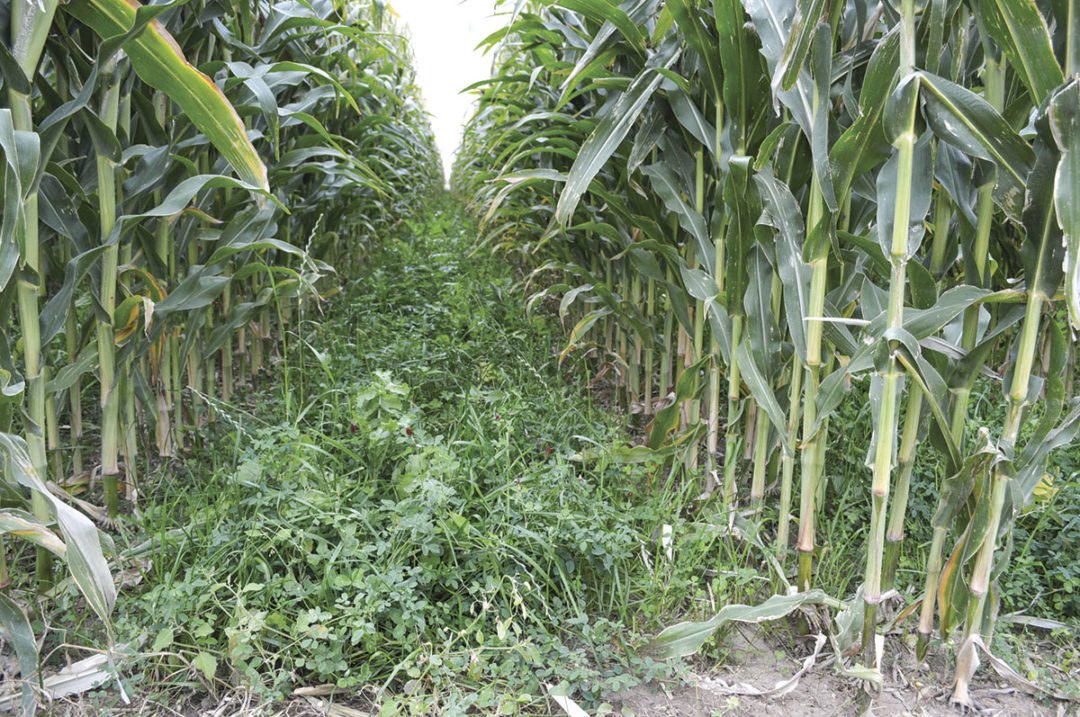In 2013, a group of colleagues and I started demonstrating with cover crops, with help from a Natural Resources and Conservation Service (NRCS) Conservation Innovation Grant to fund the work. At that time, we knew very little about cover crop practices, and NRCS was interested in reducing wind erosion and had made that a national priority.
Identifying producer need
After a couple years of growing cover crop demonstrations on farmers’ fields, we began working with a producer in Cassia County who wanted to interseed cover crops into existing corn being grown on 22-inch rows. The cover crop mix was flown on after the last application of herbicide was applied. The corn was about stage V6 at that time. The trial was successful, and in fact, several producers across the region are employing that practice now.
Corn on 22-inch centers does not allow much sunlight to hit the soil surface once rows close. The cover crop would germinate, and then growth was slowed through the summer as the corn grew tall over it, blocking sunlight. Where sunlight could reach the cover crops, such as along pivot tracks and row ends, they grew very well and lush. The idea with this practice is that once corn has been harvested for silage in September, the cover crop would grow until freezing out in October, and then cattle could graze the forage through the winter.
Maintaining yield questioned
When the silage first comes off, there isn’t much cover crop in the field, and depending on the year, there may not be much growing season, or water, left to bring a good forage crop. I started reading several articles about producers in the Midwest who were growing cover crops in corn, with the corn planted on wider-than-normal rows. The fields were to be harvested for grain, and row widths varied from about 36 to 60 inches. Once the corn started to dry down, the canopy would open and allow more late-season sunlight to reach the cover crops. Grain corn comes off earlier in much of the Midwest than it does here. Roughly 85% of the corn grown here is used for silage, so it made sense to me to develop a demonstration to see if I could grow silage corn on twin rows – skipping every other row but maintaining population – and maintain silage yield while producing a cover crop ready to graze the day the corn comes off the field.
The silage yield test
We set up a study at the University of Idaho Kimberly Research and Extension Center farm using twin rows on 44- and 60-inch centers and used 30-inch centers as the check. Twin rows were used because the planters at the research farm use a sprocket and chain transmission, which can’t be set to a high enough population for a single row, and modern harvester rotary heads can cut any width row. We selected 44- and 60-inch centers because 22- and 30-inch are the standard corn row widths used in this area.
The study was first planted in 2020 and will conclude its third year this fall when we harvest, so the results discussed in this article are for the 2020 and 2021 growing seasons. In 2020, a 99-day corn was planted May 8 and the cover crop was interseeded June 26, at approximately V6 stage. We planted the cover crop with a hand-crank broadcast spreader to simulate aerial application. No additional manipulation of the soil was conducted, and sprinkler irrigation was used to provide seed/soil contact.
In 2021, an 88-day corn was planted May 13 and interseeded with the cover crop on June 15 at approximately V4 stage. The cover crop was planted with the broadcast spreader, and a rotary hoe was pulled over the field to help break the crust and provide for better seed/soil contact.
No cover crop was planted in the 30-inch check treatment either year.
In 2020, the 30-inch check yielded 31 tons per acre, the 60-inch treatment yielded 27 tons per acre and the 44-inch treatment yielded 35 tons per acre. There was a statistical difference between the interseeded treatments, but none with the check.
A producer might argue that 4 tons an acre is a financial difference. In 2021, the 30-inch check yielded 35 tons per acre, the 60-inch treatment yielded 32 tons per acre and the 44-inch treatment yielded 36 tons per acre. Again, there was a statistical difference between the interseeded treatments, but none with the check.
The 44-inch-wide rows yielded the best of all treatments both years. I found this result interesting as my hypothesis was that the 60-inch rows would allow maximum sunlight to the corn and the cover crop. We will see if a similar result occurs this year. It should be noted that two different planters were used (22 inch and 30 inch), but the populations were very close by stand counts.
The cover crop yield test
The resultant cover crop was yield sampled the day before harvest both years, and in 2021, again on Nov. 11. A second sample wasn’t taken in 2020 as the cover crop froze down mid-October, before we could sample it. In 2020, the 60-inch treatment yielded 0.91 ton per acre dry matter on Sept. 17, and the 44-inch treatment yielded 0.58 ton per acre dry matter. In 2021, the 60-inch treatment yielded 0.33 ton per acre dry matter on Sept. 6 and 0.70 ton per acre dry matter on Nov. 11. The 44-inch treatment yielded 0.49 ton per acre dry matter and 0.57 ton per acre dry matter on the same dates. For perspective, the Cassia County study mentioned earlier ran 0.35-0.40 ton per acre dry matter sampled in mid-October.
What we’ve learned so far
What we have learned so far is: Yes, it is possible to grow corn on wider rows and maintain silage yield while providing a better environment for the growth of cover crops. There are still many questions we need to answer, such as single-row planting at high rates, ideal row width, ideal cover crop mix, etc. I suppose the ultimate question is why do this at all? I think there are three applications: forage, winter soil cover and soil health practices.








